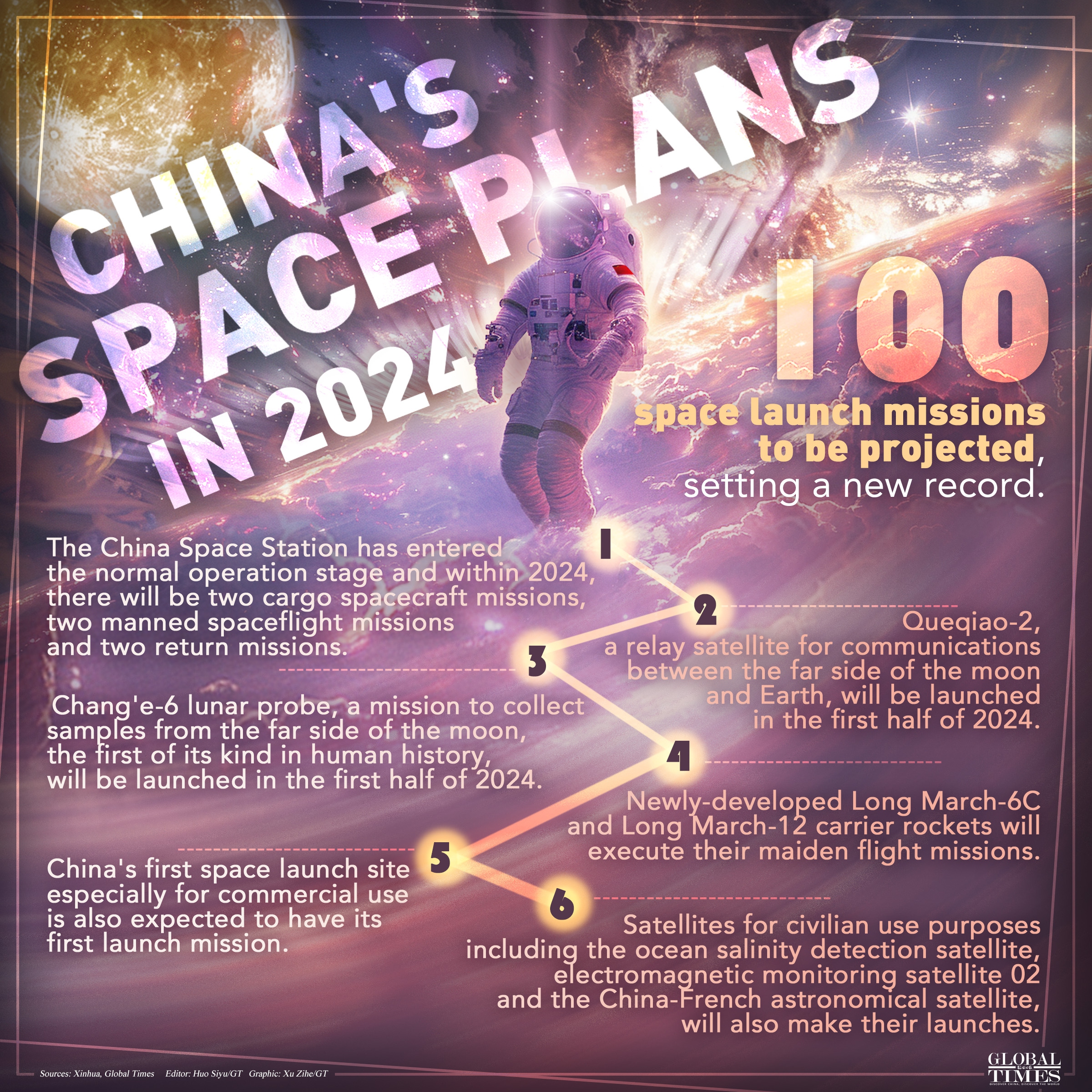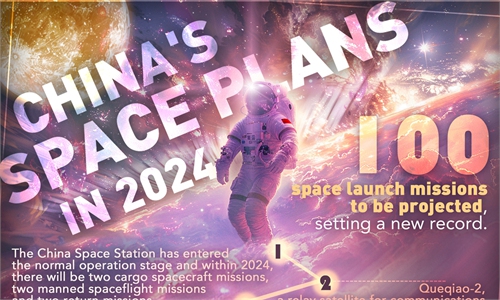SCI-TECH / AIR & SPACE
China's space program to keep strong momentum in 2024: CASC

China's space plans in 2024. Graphic:Xu Zihe/GT
China's space program is set to maintain positive momentum in 2024, with major programs including ones related to the China Space Station, manned moon landing, and Chang'e lunar probe missions, being expected to achieve solid progress, China Aerospace Science and Technology Corp (CASC), a state-owned conglomerate and the nation's leading space contractor, revealed on the sidelines of the ongoing two sessions on Monday.
The CASC, in a statement it provided to the Global Times on Monday, disclosed that in 2024, the China Space Station will continue its normalized operation, providing strong support for in-orbit scientific experiments.
To be specific, two cargo spacecraft launching missions - Tianzhou -7, -8, two crewed spacecraft launch missions - Shenzhou-18, -19, have been scheduled for the year of 2024, and two crewed return missions for Shenzhou-17 and -18 will be also executed.
It is worth noting that the enhanced version of Tianzhou cargo spacecraft has increased its payload capacity to 7.4 ton from 6.9 ton. And as of now, more than 100 space science and application programs covering disciplines including space life science, microgravity research and space new technology, have been arranged up to the space station and some have yielded staged application results, per the CASC.
The CASC is the leading contractor for the development of all spacecraft supporting the China Space Station missions, such as the Tianzhuo, Shenzhou spacecraft, and Long March-2F, Long March-5B and Long March 7 carrier rockets.
China's highly-anticipated manned moon landing program has also been activated in 2024, aiming to send taikonauts to the Earth's natural satellite before 2030 and to carry out lunar scientific exploration and related technological experiment.
According to the CASC, the program targets to achieve a variety of goals, including landing, roving, sampling, researching and returning missions, and to establish the independent capabilities for manned moon probe.
The preliminary plan for manned lunar exploration involves using two carrier rockets to separately send a lunar lander and a manned spacecraft to the Earth-Moon transfer orbit, where the spacecraft and the lander will rendezvous and dock in lunar orbit.
Comprehensive deployment and research work related to the program have been fully initiated, including the development of a new-generation of manned carrier rockets, a new-generation of manned spacecraft, lunar landers, lunar suits, and other products. At the same time, there is a wide call for proposals from the society for lunar scientific payloads and manned lunar rover development plans, per the CASC.
The CASC disclosed that the development new-generation manned carrier rocket that is expected to possess the capability of sending payload of 27 ton to the Earth-lunar transfer orbit and that of 70 ton to the near-Earth orbit, is progressing orderly. The new powerful rocket is expected to be ready for maiden flight by 2027.
In terms of robotic lunar probe, the CASC said that the Phase-4 of the country's renowned Chang'e series, is smoothly going forward. After carrying out Chang'e-6, -7, and -8 missions, the construction of the basic form of China's robotic lunar research station comprising the lunar orbiter and lunar surface probe at the south pole of moon will be completed.
To achieve that, in 2024, China will launch the Queqiao-2 relay communication satellite and the Chang'e-6 mission aiming to return lunar samples in the South Pole-Aitken Basin on the far side of the moon, which would mark a human first, will be also launched.
In 2024, the conglomerate will comprehensively advance an asteroid exploration project, initiate the development of Tianwen-2, and plan to explore near-Earth asteroids and main-belt comets around 2025.
In the future, the CASC vowed to also accomplish key technological breakthroughs such as Mars sample return, exploration of the Jupiter system, and discuss implementation plans for asteroid defense, among other initiatives.


